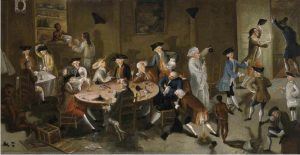Amanda Cargill in Smithsonian:
 As we commence celebrating July 4th with the time-honored traditions of beer, block parties and cookouts, it’s fun to imagine a cookout where the Founding Fathers gathered around a grill discussing the details of the Declaration of Independence. Did George Washington prefer dogs or burgers? Was Benjamin Franklin a ketchup or mustard guy? And why did they all avoid drinking water?
As we commence celebrating July 4th with the time-honored traditions of beer, block parties and cookouts, it’s fun to imagine a cookout where the Founding Fathers gathered around a grill discussing the details of the Declaration of Independence. Did George Washington prefer dogs or burgers? Was Benjamin Franklin a ketchup or mustard guy? And why did they all avoid drinking water?
…George Washington was exceedingly fond of dining on seafood. For nearly 40 years, the three fisheries he operated along the ten-mile Potomac shoreline that bordered Mount Vernon processed more than a million fish annually. Among the items on the plantation’s menu were crabmeat casseroles, oyster gumbos and salmon mousse.
Thomas Jefferson admired French fare above all, and he is credited, according to Staib, with popularizing frites, ice cream and champagne. He is also often credited—although incorrectly—with the introduction of macaroni and cheese to the American palate. It was, in fact, his enslaved chef James Hemings who, via Jefferson’s kitchen, brought the creamy southern staple to Monticello. Trained at the elite Château de Chantilly while accompanying Jefferson on a trip to France, Hemings would later become one of only two laborers enslaved by Jefferson to negotiate his freedom.
As for dessert, none of the Founding Fathers was without a sweet tooth. John Adams’ wife, Abigail, regularly baked Apple Pan Dowdy, a pie-meets-cobbler hybrid that was popular in New England in the early 1800s; James Madison loved ice cream and was spoiled by his wife Dolley’s creative cakes, for which she gained such renown that, to this day, supermarkets across America carry a brand of prepared pastries bearing her—albeit incorrectly spelled—name; and John Jay, in a letter sent to his father in 1790, reported that he carried chocolate with him on long journeys, likely “shaving or grating it into pots of milk,” says Kevin Paschall, chocolate maker at Philadelphia’s historic Shane Confectionery, and consuming it as a drink.
More here.
